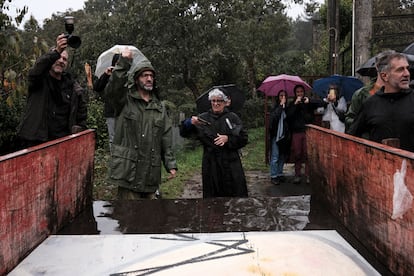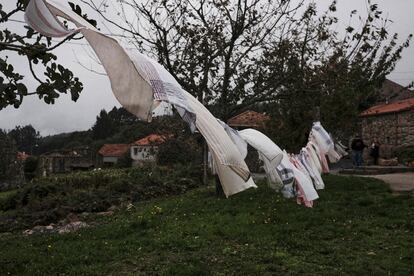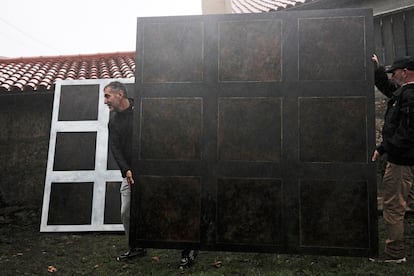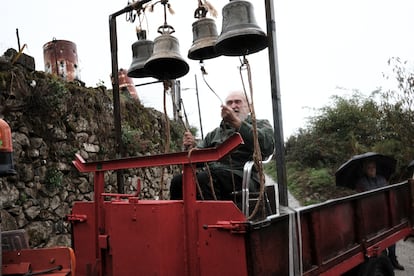The girl Edea asks and Manolo, with his blue overalls, wellies and protective glasses, answers: “let’s burn all that.” It is 3:50 p.m. on Saturday, October 5, and “that” is not the stubble or branches that are burned at this time of year to clean the countryside, but rather 51 works that the artist Elena del Rivero (Valencia, 75 years old) made over the years. seventy and eighty. Spaniard living in New York since 1991, her work is in the collections of the Metropolitan and the MoMA in New York, in the National Gallery of Art in Washington, the Reina Sofía Museum and the MACBA. Now, fifty paintings from the beginning of his career are stacked in a clearing, directly on the mud resulting from a morning of intense rain, something that everyone here, in San Pedro Fiz de Vilar, has regretted, because, as so often, passes “it was very sunny yesterday.”
The residents of this village, which has a herd of goats and cows and a beekeeper with dozens of hives, have a total of 11 inhabitants throughout the year, but in this unique happening artistic pilgrimage dozens of family and friends have come. There are cameras documenting this story and some guests, but outsiders are in a clear minority.
The works burned by Del Rivero were created in Madrid and during her stay at the Spanish Academy in Rome and coexisted with her and her daughter Violeta, who also attended the pyre. The paintings arrived in San Pedro last January, thanks to Mateo Feijóo, choreographer, art curator and grandson of some residents of this village. The man who was director of the Naves del Matadero and La Laboral in Gijón stayed with his grandparents’ house here a few years ago, in A Casa do Pozo, and started a conversation with the villagers to start an artistic project that they did not know. was alien.
Del Rivero’s paintings have been in the houses, corrals, oreos, haystacks and even pigsties of San Pedro for the last 10 months awaiting the day of the burning, which this October 5 has been celebrated as a big festival in the village, that is that is, with mass, slaughter of a pig weighing more than 100 kilos and popular food in a tent. The music was provided by the musicologist, composer and sound artist Llorenç Barber (Valencia, 76 years old), an accomplice in more than one of Del Rivero’s works.
After the mass, a suggestion for the celebration of this day by the neighbors, the Llorenç concert started despite the downpour, in which the area band also participated. Then, getting on a tractor where his bells were installed, sitting in a chair and covered with a raincoat and even an oilcloth tablecloth, the rain did not stop at any time the festive bells with which the artist accompanied the transfer of the paintings. Del Rivero from its location in the village to the pyre. In total, 16 stops that started at Mary Flor’s house. From Benito’s pigsty came the fabric without a frame that has accompanied the three pigs that are being fattened until their San Martín arrives.
Del Rivero remembers precisely how each of these works reflected the concerns and influences he felt as a young artist, from the neo-impressionism of Anselm Kiefer to the geometry of Agnes Martin. In those paintings was his exploration in the artistic field and his life at that time. But he says that he is not worried about burning them, because from there new work emerges and will emerge. The paintings will be ashes and from there conceptual pieces will emerge, which dragged another story. “I want to play with chance and see what comes of all this,” explained Del Rivero, who already has several series underway based on what he experienced in San Pedro. Two museums have been interested in this project. The burning

In 2001, his studio and home on Cedar Street, next to the Twin Towers in New York, was covered in dust and full of papers and debris after the September 11 attacks. Del Rivero began to work with all that and from there was born The dust archiveone of his most powerful works, which lasted for two decades. “That was an external act. But now I thought that I can cause disaster with this burning and return to creation from destruction,” he noted. Does this have something of a Valencian falla? “I hadn’t thought about it, rather I connected it with Susan Hiller, who burned a painting of hers every year, but perhaps it is related. In the ashes I found a guideline to create. “I feel a bit heretic.”
The neighbors, umbrellas in hand, joined the procession and helped load and unload the works. “I don’t really understand why we burn such an exquisite work,” said Benito who, like everyone here, has accepted that that is what the artist wanted to do. “It’s not our decision, it’s part of the project,” says Martín, 12, who along with Xoel and Antón contemplates the flames from the tractor where the Barber bells are. Del Rivero has donated a painting to the church and will give them photographic reproductions of the burned work.
When the flames grew, Alicia sighed: “What a shame to burn all this!” Meanwhile, the artist was already thinking about how to collect the remains of the bonfire and whether any frame would survive the fire. Late in the afternoon a group of bagpipers from the area arrived, when a few embers from the pyre were burning, and the queimada was being prepared among the neighbors. The cooks of the pig, slaughtered the day before, came from neighboring Portugal.

A few meters from the fire, the kitchen cloths that for years Del Rivero asked friends and family to send him for installation were fluttering like party flags. Rag Line (2021), one of the works in which he managed to vindicate and give a new poetic meaning to the domestic. Here, in Ourense, the rags seem to somehow close a circle: Del Rivero’s work leaves home and returns to it in an unusual way in this village. The same goes for the three big flags with the word “mother”which refer to the work of Letters to mother which the artist did inspired by Kafka and the Czech’s correspondence with his father. There are also scattered false pearls in San Pedro, an element that has marked Del Rivero’s work (“everything came to me from María Zambrano,” she pointed out), and that emerges like grass that has grown spontaneously in the corners.
In person and later from New York by videoconference, Del Rivero spoke with the neighbors to explain her work and they accepted the challenge and even began to make their own installations on walls and nooks that the artist later finished off with her pearls. In an alley, Del Rivero unfurled a banner that reads O Meighaloho with an offering of potatoes at the feet, a kind of spell evoked by this word in ancient Galician.
The flames that consumed Del Rivero’s work have something of a rebellious review of his career, a forceful declaration that the past will not be able to ossify the present, nor curtail the future. Hence the name of this project: The burning A retrospective. “This relieves the ego. My work is materials, moments and literature, and here all the nooks and crannies are shown.” On Sunday, once the party was over, it was time to collect the ashes behind the flames, because The burning It has only just begun.


